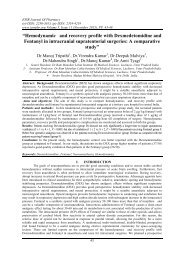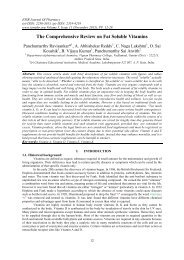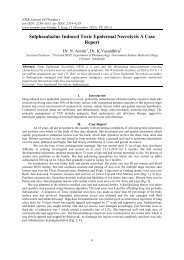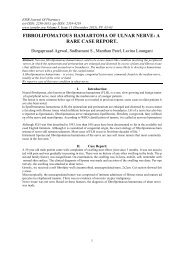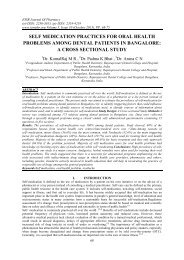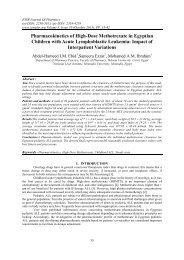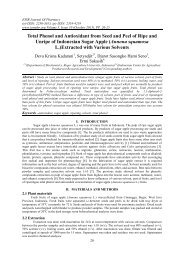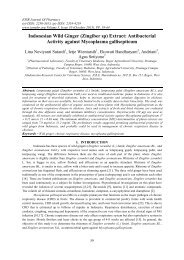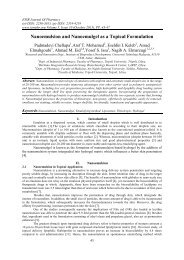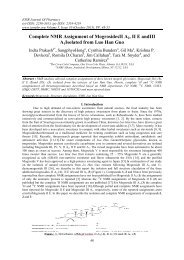Correlation of Estrogen and Progesterone Receptor expression in Breast Cancer
The IOSR Journal of Pharmacy (IOSRPHR) is an open access online & offline peer reviewed international journal, which publishes innovative research papers, reviews, mini-reviews, short communications and notes dealing with Pharmaceutical Sciences( Pharmaceutical Technology, Pharmaceutics, Biopharmaceutics, Pharmacokinetics, Pharmaceutical/Medicinal Chemistry, Computational Chemistry and Molecular Drug Design, Pharmacognosy & Phytochemistry, Pharmacology, Pharmaceutical Analysis, Pharmacy Practice, Clinical and Hospital Pharmacy, Cell Biology, Genomics and Proteomics, Pharmacogenomics, Bioinformatics and Biotechnology of Pharmaceutical Interest........more details on Aim & Scope).
The IOSR Journal of Pharmacy (IOSRPHR) is an open access online & offline peer reviewed international journal, which publishes innovative research papers, reviews, mini-reviews, short communications and notes dealing with Pharmaceutical Sciences( Pharmaceutical Technology, Pharmaceutics, Biopharmaceutics, Pharmacokinetics, Pharmaceutical/Medicinal Chemistry, Computational Chemistry and Molecular Drug Design, Pharmacognosy & Phytochemistry, Pharmacology, Pharmaceutical Analysis, Pharmacy Practice, Clinical and Hospital Pharmacy, Cell Biology, Genomics and Proteomics, Pharmacogenomics, Bioinformatics and Biotechnology of Pharmaceutical Interest........more details on Aim & Scope).
You also want an ePaper? Increase the reach of your titles
YUMPU automatically turns print PDFs into web optimized ePapers that Google loves.
<strong>Correlation</strong> <strong>of</strong> <strong>Estrogen</strong> <strong>and</strong> <strong>Progesterone</strong> <strong>Receptor</strong> <strong>expression</strong> <strong>in</strong> <strong>Breast</strong> <strong>Cancer</strong><br />
II. METHODS<br />
The study has been carried out on 350 breast cancer patients diagnosed <strong>and</strong> treated at Mahavir <strong>Cancer</strong><br />
Institute <strong>and</strong> Research Centre <strong>and</strong> were classified accord<strong>in</strong>g to their ER/PR <strong>expression</strong>. The study was approved<br />
by the ethics committee <strong>of</strong> Mahavir <strong>Cancer</strong> Institute <strong>and</strong> Research Centre, Patna, Bihar, India. All the patients<br />
were <strong>in</strong>volved voluntarily <strong>in</strong> this study. The IHC assays for ER <strong>and</strong> PR were performed on 3 μm sections<br />
unsta<strong>in</strong>ed slide from paraff<strong>in</strong> block <strong>and</strong> float mounted on plus-coated glass slides. The methodology for ER <strong>and</strong><br />
PR were same as for each antibody <strong>and</strong> each batch, positive <strong>and</strong> negative controls were used. Human endocervix<br />
was used as a positive control because <strong>of</strong> its easy availability <strong>and</strong> relatively stable reactivity. The negative<br />
control consisted <strong>of</strong> non-immune mouse IgG substituted for the primary antibody.<br />
Samples were obta<strong>in</strong>ed from biopsy <strong>and</strong> analyzed for ER/PR <strong>expression</strong> through Immunohistochemistry (IHC).<br />
Data were collected <strong>and</strong> statistically analysis was performed accord<strong>in</strong>g to statistical package <strong>of</strong> Graph pad<br />
Prism. The blood group frequencies were compared us<strong>in</strong>g Chi- square test. Power <strong>of</strong> study was 80% while<br />
confidence Interval (CI) was 95%.<br />
III. RESULTS<br />
It was observed that mean age <strong>of</strong> ER+ positive breast cancer patients were 47 years, while mean age <strong>of</strong><br />
PR positive patient were 44 years (Graph -I). ER was positive <strong>in</strong> 60.1% patients while ER is negative <strong>in</strong> 39.9%<br />
patients. PR is positive <strong>in</strong> 55.67 % while PR was negative <strong>in</strong> 44.33% patients. Two third patients had either ER<br />
or PR is positive while one third had both negative. In our study we observed 6.4 % patients with ER negative<br />
<strong>and</strong> PR positive (Graph –II, Table - 1).<br />
IV. DISCUSSIONS<br />
The biologic, prognostic <strong>and</strong> predictive importance <strong>of</strong> assessment <strong>of</strong> estrogen receptor (ER) <strong>expression</strong><br />
<strong>in</strong> breast cancer is well established; however, the added value <strong>of</strong> progesterone receptor (PR) assessment is<br />
controversial 7, 8 . S<strong>in</strong>ce the 1970s, it has been hypothesized that PR <strong>expression</strong> is associated with response to<br />
hormonal therapies <strong>in</strong> ER+ breast cancer, as it is thought that ER <strong>and</strong> PR co-<strong>expression</strong> demonstrates a<br />
functionally <strong>in</strong>tact estrogen response pathway 9, 10 . Analyses from observational studies showed that loss <strong>of</strong> PR<br />
<strong>expression</strong> was associated with worse overall prognosis among ER+ breast cancers 11, 12, 13, 14, 15 .<br />
These results suggested that evaluation <strong>of</strong> PR status <strong>in</strong> ER+ breast cancer might be used to help guide cl<strong>in</strong>ical<br />
management, as high levels <strong>of</strong> PR <strong>expression</strong> may identify a subset <strong>of</strong> ER+ patients most likely to benefit from<br />
hormonal therapy 16 .<br />
The presence <strong>of</strong> ER, as detected by IHC, is a weak prognostic marker <strong>of</strong> cl<strong>in</strong>ical outcome <strong>in</strong> breast cancer 17 but<br />
a strong predictive marker for response 18 to tamoxifen-based therapy. Recent studies have demonstrated that ER<br />
<strong>expression</strong> is present <strong>in</strong> approximately 70% <strong>of</strong> breast cancers, 19 so an accurate <strong>and</strong> reliable ER result is critical<br />
for hormone therapy.<br />
One <strong>of</strong> the <strong>in</strong>terest<strong>in</strong>g results <strong>in</strong> our study observed was that ER-/PR+ was found only <strong>in</strong> one case out <strong>of</strong> 137<br />
malignant cases. Such f<strong>in</strong>d<strong>in</strong>gs were also reported by Olivotto, et al., 20 as they found only one case out <strong>of</strong> 192<br />
with ER- have PR+ with weak positive immune-sta<strong>in</strong><strong>in</strong>g. These results were strongly challenged by 21 Colomer,<br />
et al., reported ER+/PR+, ER+/PR–, ER–/PR+, <strong>and</strong> ER–/PR– <strong>in</strong> 46%, 19%, 7% <strong>and</strong> 28%, respectively.<br />
In the present study we also observed 6.4% cases <strong>of</strong> ER-ve <strong>and</strong> PR+ve group, which <strong>in</strong>dicates that this group is<br />
also a important subtypes <strong>of</strong> breast cancer patients.<br />
It has further been suggested that PR status is <strong>in</strong>dependently associated with disease-free <strong>and</strong> overall survival,<br />
that is, patients with ER-positive/PR-positive tumors have a better prognosis than patients with ER-positive/PRnegative<br />
tumors, who <strong>in</strong> turn have a better prognosis than patients with ER-negative/PR-negative tumors. 22<br />
Thus it is concluded that two third <strong>of</strong> breast cancer patients were positive for hormone receptor. ER/PR positive<br />
<strong>in</strong>dicates over-<strong>expression</strong> <strong>of</strong> estrogen <strong>and</strong> progesterone <strong>in</strong> carc<strong>in</strong>oma breast. ER negative <strong>and</strong> PR positive group<br />
were also observed <strong>in</strong> significant number <strong>of</strong> breast cancer patients. ER negative was observed <strong>in</strong> early age group<br />
<strong>of</strong> breast cancer while PR negative were observed <strong>in</strong> higher age group patients.<br />
V. ACKNOWLEDGEMENT<br />
The authors are thankful to all faculties <strong>and</strong> staff <strong>of</strong> Mahavir <strong>Cancer</strong> Institute <strong>and</strong> Research Centre, Patna for<br />
their proper support dur<strong>in</strong>g this study.<br />
REFERENCES<br />
[1]. Lal P, Chen B. <strong>Correlation</strong> <strong>of</strong> HER-2 status with estrogen <strong>and</strong> progesterone receptors <strong>and</strong> histological<br />
features <strong>in</strong> 3,655 <strong>in</strong>vasive breast cancers. American Journal <strong>of</strong> Cl<strong>in</strong>ical Pathology, 2005, 123 (4): 541-6,<br />
[2]. Carey L A, Perou C M, Livasy C A,et al. Race breast cancer subtypes <strong>and</strong> survival <strong>in</strong> the Carol<strong>in</strong>a breast<br />
cancer study. JAMA, 2006, 295: 2492- 502,<br />
[3]. Park<strong>in</strong> DM, Bray F, Ferlay J, Pisani P. Global cancer statistics-2002. CA <strong>Cancer</strong> J Cl<strong>in</strong> 2005; 55: 74-108.<br />
40




